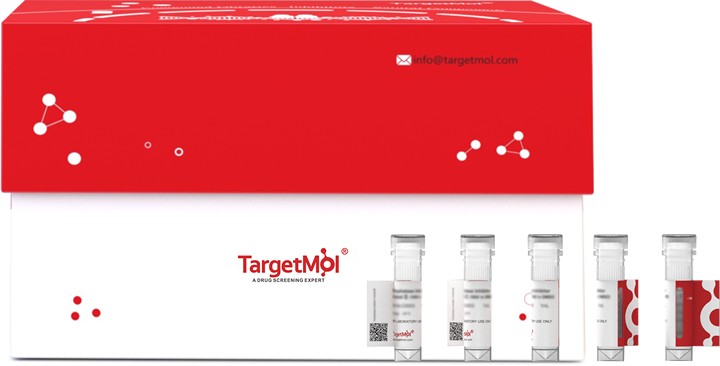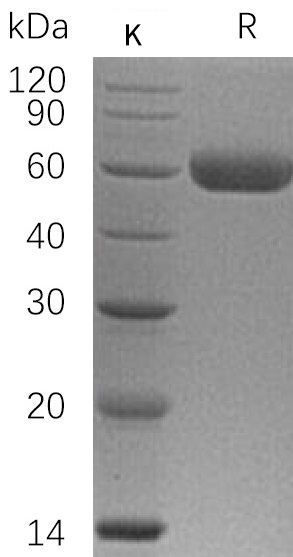- 全部删除
 您的购物车当前为空
您的购物车当前为空
Osteoprotegerin Protein, Human, Recombinant (aa 22-401, His)
TNFRSF11B is a secreted protein, containing 2 death domains and 4 TNFR-Cys repeats. TNFRSF11B is a decoy receptor for the receptor activator of nuclear factor kappa B ligand (RANKL). By binding RANKL, TNFRSF11B inhibits nuclear kappa B (NF-κB) which is a central and rapid acting transcription factor for immune-related genes, and a key regulator of inflammation, innate immunity, and cell survival and differentiation. TNFRSF11B levels are influenced by voltage-dependent calcium channelsCav1.2. TNFRSF11B can reduce the production of osteoclasts by inhibiting the differentiation of osteoclast precursors (osteoclasts are related to monocytes/macrophages and are derived from granulocyte/macrophage-forming colony units (CFU-GM)) into osteoclasts and also regulates the resorption of osteoclasts in vitroand in vivo. TNFRSF11B binding to RANKL on osteoblast/stromal cells, blocks the RANKL-RANK ligand interaction between osteoblast/stromal cells and osteoclast precursors. This has the effect of inhibiting the differentiation of the osteoclast precursor into a mature osteoclast.

Osteoprotegerin Protein, Human, Recombinant (aa 22-401, His)
| 规格 | 价格 | 库存 | 数量 |
|---|---|---|---|
| 10 μg | ¥ 300 | 现货 | |
| 20 μg | ¥ 490 | 5日内发货 | |
| 50 μg | ¥ 930 | 5日内发货 |
产品信息
| 生物活性 | Activity has not been tested. It is theoretically active, but we cannot guarantee it. If you require protein activity, we recommend choosing the eukaryotic expression version first. |
| 产品描述 | TNFRSF11B is a secreted protein, containing 2 death domains and 4 TNFR-Cys repeats. TNFRSF11B is a decoy receptor for the receptor activator of nuclear factor kappa B ligand (RANKL). By binding RANKL, TNFRSF11B inhibits nuclear kappa B (NF-κB) which is a central and rapid acting transcription factor for immune-related genes, and a key regulator of inflammation, innate immunity, and cell survival and differentiation. TNFRSF11B levels are influenced by voltage-dependent calcium channelsCav1.2. TNFRSF11B can reduce the production of osteoclasts by inhibiting the differentiation of osteoclast precursors (osteoclasts are related to monocytes/macrophages and are derived from granulocyte/macrophage-forming colony units (CFU-GM)) into osteoclasts and also regulates the resorption of osteoclasts in vitroand in vivo. TNFRSF11B binding to RANKL on osteoblast/stromal cells, blocks the RANKL-RANK ligand interaction between osteoblast/stromal cells and osteoclast precursors. This has the effect of inhibiting the differentiation of the osteoclast precursor into a mature osteoclast. |
| 种属 | Human |
| 表达系统 | HEK293 Cells |
| 标签 | C-6xHis |
| 蛋白编号 | O00300 |
| 别名 | Tumor Necrosis Factor Receptor Superfamily Member 11B,TNFRSF11B,Osteoprotegerin,Osteoclastogenesis Inhibitory Factor,OPG,OCIF |
| 氨基酸序列 | Glu22-Leu401 |
| 蛋白构建 | Glu22-Leu401 |
| 蛋白纯度 | Greater than 95% as determined by reducing SDS-PAGE. (QC verified)  |
| 内毒素 | < 0.1 ng/µg (1 EU/µg) as determined by LAL test. |
| 缓冲液 | Lyophilized from a solution filtered through a 0.22 μm filter, containing 20 mM PB, 150 mM NaCl, pH 7.4. |
| 复溶方法 | Reconstitute the lyophilized protein in distilled water. The product concentration should not be less than 100 μg/ml. Before opening, centrifuge the tube to collect powder at the bottom. After adding the reconstitution buffer, avoid vortexing or pipetting for mixing. |
| 存储 | It is recommended to store recombinant proteins at -20°C to -80°C for future use. Lyophilized powders can be stably stored for over 12 months, while liquid products can be stored for 6-12 months at -80°C. For reconstituted protein solutions, the solution can be stored at -20°C to -80°C for at least 3 months. Please avoid multiple freeze-thaw cycles and store products in aliquots. |
| 运输方式 | In general, Lyophilized powders are shipping with blue ice. |
| 研究背景 | TNFRSF11B is a secreted protein, containing 2 death domains and 4 TNFR-Cys repeats. TNFRSF11B is a decoy receptor for the receptor activator of nuclear factor kappa B ligand (RANKL). By binding RANKL, TNFRSF11B inhibits nuclear kappa B (NF-κB) which is a central and rapid acting transcription factor for immune-related genes, and a key regulator of inflammation, innate immunity, and cell survival and differentiation. TNFRSF11B levels are influenced by voltage-dependent calcium channelsCav1.2. TNFRSF11B can reduce the production of osteoclasts by inhibiting the differentiation of osteoclast precursors (osteoclasts are related to monocytes/macrophages and are derived from granulocyte/macrophage-forming colony units (CFU-GM)) into osteoclasts and also regulates the resorption of osteoclasts in vitroand in vivo. TNFRSF11B binding to RANKL on osteoblast/stromal cells, blocks the RANKL-RANK ligand interaction between osteoblast/stromal cells and osteoclast precursors. This has the effect of inhibiting the differentiation of the osteoclast precursor into a mature osteoclast. |




